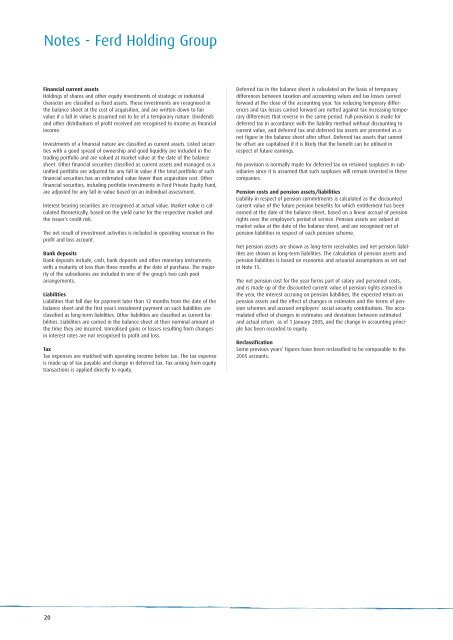Annual Report 2005
Annual Report 2005
Annual Report 2005
Create successful ePaper yourself
Turn your PDF publications into a flip-book with our unique Google optimized e-Paper software.
Notes - Ferd Holding Group<br />
Financial current assets<br />
Holdings of shares and other equity investments of strategic or industrial<br />
character are classified as fixed assets. These investments are recognised in<br />
the balance sheet at the cost of acquisition, and are written down to fair<br />
value if a fall in value is assumed not to be of a temporary nature. Dividends<br />
and other distributions of profit received are recognised to income as financial<br />
income.<br />
Investments of a financial nature are classified as current assets. Listed securities<br />
with a good spread of ownership and good liquidity are included in the<br />
trading portfolio and are valued at market value at the date of the balance<br />
sheet. Other financial securities classified as current assets and managed as a<br />
unified portfolio are adjusted for any fall in value if the total portfolio of such<br />
financial securities has an estimated value lower than acquisition cost. Other<br />
financial securities, including portfolio investments in Ferd Private Equity Fund,<br />
are adjusted for any fall in value based on an individual assessment.<br />
Interest bearing securities are recognised at actual value. Market value is calculated<br />
theoretically, based on the yield curve for the respective market and<br />
the issuer’s credit risk.<br />
The net result of investment activities is included in operating revenue in the<br />
profit and loss account.<br />
Bank deposits<br />
Bank deposits include, cash, bank deposits and other monetary instruments<br />
with a maturity of less than three months at the date of purchase. The majority<br />
of the subsidiaries are included in one of the group’s two cash pool<br />
arrangements.<br />
Liabilities<br />
Liabilities that fall due for payment later than 12 months from the date of the<br />
balance sheet and the first year’s instalment payment on such liabilities are<br />
classified as long-term liabilities. Other liabilities are classified as current liabilities.<br />
Liabilities are carried in the balance sheet at their nominal amount at<br />
the time they are incurred. Unrealised gains or losses resulting from changes<br />
in interest rates are not recognised to profit and loss.<br />
Tax<br />
Tax expenses are matched with operating income before tax. The tax expense<br />
is made up of tax payable and change in deferred tax. Tax arising from equity<br />
transactions is applied directly to equity.<br />
20<br />
Deferred tax in the balance sheet is calculated on the basis of temporary<br />
differences between taxation and accounting values and tax losses carried<br />
forward at the close of the accounting year. Tax reducing temporary differences<br />
and tax losses carried forward are netted against tax increasing temporary<br />
differences that reverse in the same period. Full provision is made for<br />
deferred tax in accordance with the liability method without discounting to<br />
current value, and deferred tax and deferred tax assets are presented as a<br />
net figure in the balance sheet after offset. Deferred tax assets that cannot<br />
be offset are capitalised if it is likely that the benefit can be utilised in<br />
respect of future earnings.<br />
No provision is normally made for deferred tax on retained surpluses in subsidiaries<br />
since it is assumed that such surpluses will remain invested in these<br />
companies.<br />
Pension costs and pension assets/liabilities<br />
Liability in respect of pension commitments is calculated as the discounted<br />
current value of the future pension benefits for which entitlement has been<br />
earned at the date of the balance sheet, based on a linear accrual of pension<br />
rights over the employee’s period of service. Pension assets are valued at<br />
market value at the date of the balance sheet, and are recognised net of<br />
pension liabilities in respect of each pension scheme.<br />
Net pension assets are shown as long-term receivables and net pension liabilities<br />
are shown as long-term liabilities. The calculation of pension assets and<br />
pension liabilities is based on economic and actuarial assumptions as set out<br />
in Note 15.<br />
The net pension cost for the year forms part of salary and personnel costs,<br />
and is made up of the discounted current value of pension rights earned in<br />
the year, the interest accruing on pension liabilities, the expected return on<br />
pension assets and the effect of changes in estimates and the terms of pension<br />
schemes and accrued employers’ social security contributions. The accumulated<br />
effect of changes in estimates and deviations between estimated<br />
and actual return as of 1 January <strong>2005</strong>, and the change in accounting principle<br />
has been recorded to equity.<br />
Reclassification<br />
Some previous years’ figures have been reclassified to be comparable to the<br />
<strong>2005</strong> accounts.



